Woodland creation timeline: from planning to planting
Find out what’s involved in woodland creation, and how long the process takes from scoping your landscape to planting your first tree.
Applies to England
If you’re a landowner or manager thinking about creating woodland, but you’re not sure where to start, this guide takes you through what the process looks like using government funding.
Before you begin
We can give you advice on taking your first steps towards tree planting and woodland creation, first, you should gather basic site information:
-
What are you trying to achieve? Note down your objectives for the site. This will influence your woodland design and what species you choose.
-
List any site information you have, including the grid reference, and the current and recent land use.
-
If known, note down the soil type. If unknown and enthusiastic, you can dig a soil pit (circa 30cm cubed) and photograph the horizontal layers.
-
Record any known and relevant information like designations, wayleaves, or any wildlife surveys you might have.
-
Note down whether your land is under another agri-environment scheme, as you will need to check eligibility.
-
Take photos of key landscape features such as viewpoints in and out of the site, watercourses, and public access.
Consider drawing a basic map of your findings to help visualise opportunities. This will help when you want to get more specific advice from your local woodland officer.
Talk to us
We can give you information on the different grants available for woodland planning and creation, contact your local woodland creation team.
If you decide that one of our grants is the right for your project, familiarise yourself with the application process early.
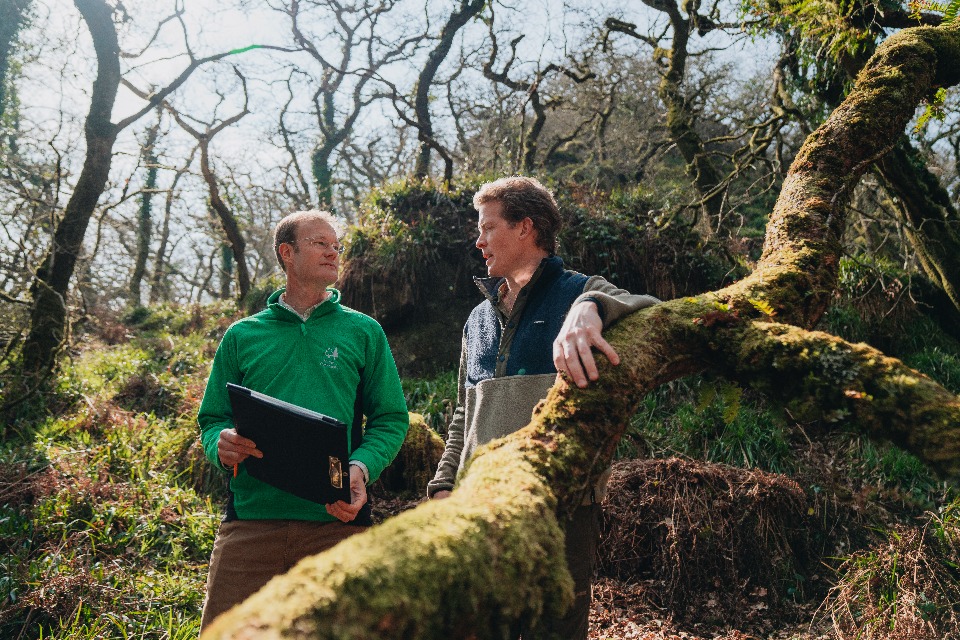
Landowner talking to Forestry Commission staff within their woodland. Crown copyright.
This path sets out the broad steps to creating woodland and an overview of what to expect. The length of your journey will vary depending on your site and its complexities.
Woodland creation benefits your land, your community, and the planet, so getting it right is important.
🕒 A woodland creation project can take anywhere from 1 year onwards.
1. Begin your journey
Once you have collected your basic site information, contact your local woodland officer. They can offer expert advice and answer any initial questions that you have.
Funding for the planning and design stage
Consider applying for planning and design funding. If your proposal is eligible for the Woodland Creation Planning Grant (WCPG), or another planning grant, apply and wait for an agreement before you start the next stages, otherwise you might not be able to access financial support.
If you have an approved plan through WCPG, you do not need to complete the ‘woodland creation plan’ sections of the England Woodland Creation Offer (EWCO) application form. This can help speed up the process.
2. Scope the project
Discuss the suitability of your site with your local woodland officer and identify the woodland potential, and who or what might be affected by it.
Review your objectives and consider tree selection, making sure the species is suited to your site’s characteristics, and what the future conditions of the site might be.
3. Register with Rural Payments service
If you’re applying for EWCO you will need to register with the Rural Payments service before an agreement can be made. You will need information such as your Single Business Identifier (SBI) and Customer Reference Number (CRN).
If you’re already registered, you should check the compatibility of woodland creation with any agri-environment schemes currently on your land.
🕒 Registration can take up to 6 weeks.
4. Early stakeholder engagement
As part of your application environmental checks, draw a basic map of your woodland using the Land Information Search tool.
Make sure you include your site’s grid reference. Share this with environmental and historic centres early to avoid delays.
You can also use your grid reference when talking to neighbours and other important stakeholders.
🕒 Your local record centre can advise you on the time frames.
Your local record centre will also advise you on any charges that apply. If your proposal is eligible, the WCPG can help with these costs.
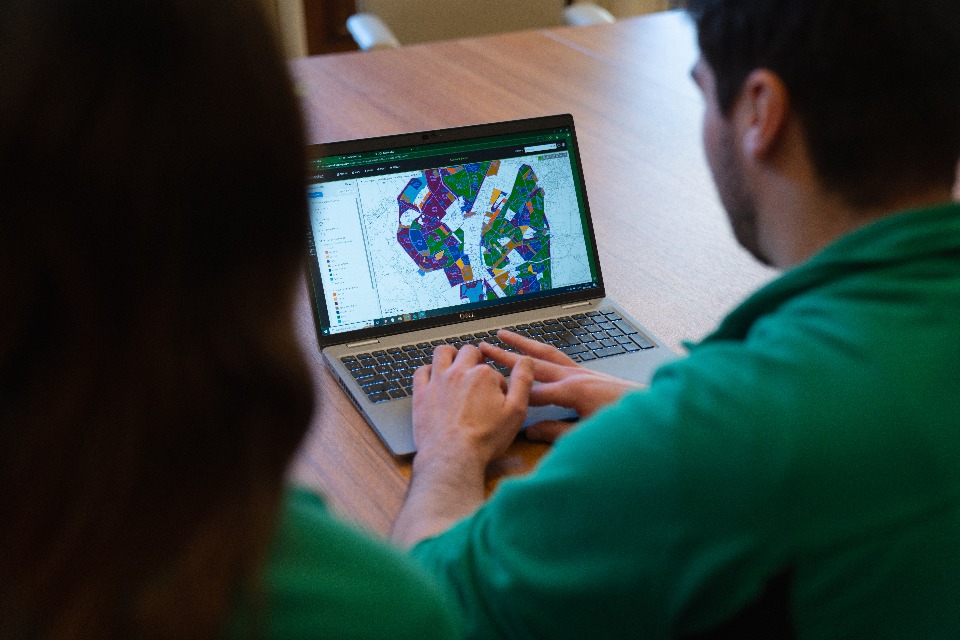
Forestry Commission staff member using mapping tool on a laptop. Crown copyright.
5. Do desk-based research to understand your site
Research the site’s context, constraints, vulnerabilities, and opportunities through a desk-based exercise. This ensures the new woodland is designed to be UKFS compliant.
Depending on the scope of your proposal, you may require stage 2 of WCPG.
Read more about the UK Forestry Standard (UKFS)’s criteria and guidance for sustainable management of forests and woodland in the UK.
6. Organise any necessary field surveys
Your desk-based research should highlight any field surveys. You will need to identify any sensitive, site-specific issues that may require extra consideration. You can carry out some of these yourself, but some might need specialist input. Your local woodland officer can advise.
🕒 Some seasonal survey dependencies including:
- Vegetation/habitat/National Vegetation Classification (NVC): April to September
- peat: any time of year, no restriction
- historic environment/archaeology: any time of year, no restriction
- breeding birds (including waders): March to July
- European Protected Species (EPS): variable throughout the year
Read more about:
ecological surveys for woodland creation.
7. Assess the impact
Analyse the impacts from both your desk-based research and field surveys. These will inform how you design and communicate your woodland creation proposal.
8. Bring your plan together
Taking what you have learnt so far, develop your design concept and draft a management plan. Use our map request service and other online tools to help you.
9. Host a site visit
A woodland officer will visit your site to review the information you have gathered to date.
We may recommend a joint visit, including any statutory bodies, if you need consent or agreement from others.
If there are unresolved matters once you submit your application, you may need to host a visit at that point.
Contact your local area woodland officer for detailed advice on visits.
🕒 Timings vary within the year.
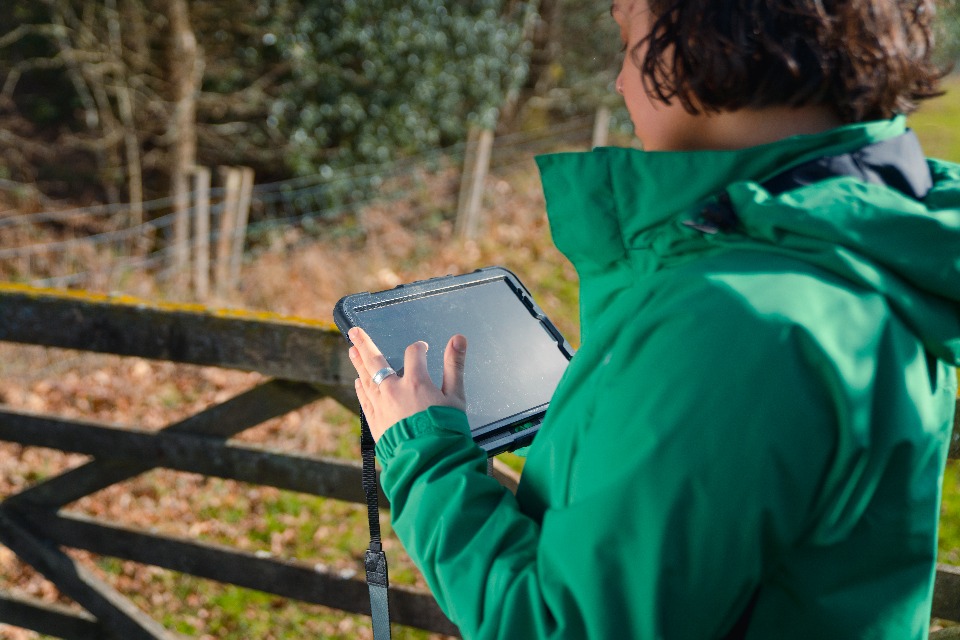
Forestry Commission staff member on site using a tablet. Crown copyright.
10. Engage with stakeholders
Explain your objectives and plans with your identified stakeholders. Share your initial design and take account of their views.
Stakeholders will include the local community, for example neighbours and parish council. Be prepared to discuss mitigation factors or adjust your objectives, if necessary.
11. Produce the final woodland creation plan
Draw together the written and graphical information you have gathered throughout the planning and design process to produce your final woodland creation plan.
This can be in the form of an annotated design plan, which illustrates the design concept.
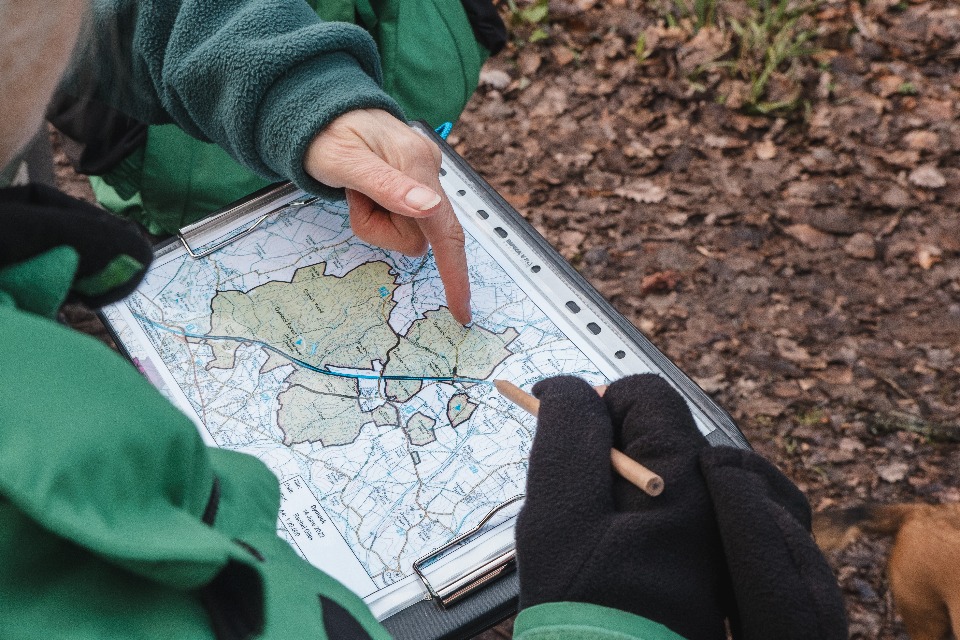
Forestry Commission staff study a map of a woodland area. Copyright: Forestry England.
Environmental Impact Assessment (EIA)
If you apply for WCPG or EWCO there is no need to request an EIA opinion or make an EIA notification separately. Your grant application will be sufficient for us to carry out the EIA process. However, if you decide not to apply for our grants, you will need to apply separately for an EIA.
You will need to carry out a new EIA if the:
- design changes significantly from your approved woodland plan
- work has not started within 5 years from the date of consent
- work has not finished within 10 years from the consent date
13. Publicise the proposal for consultation
We will place the application on the public register for comment and consult with any statutory consultees.
🕒 Public consultation can happen alongside statutory consultation. For more information on timescales visit EIAs for woodland.
14. Grant application decision
We will review your EWCO application and let you know whether you’ve been successful or unsuccessful. If you’re successful, we will issue a ‘grant offer letter’.
🕒 We aim to process eligible applications in 3 to 5 months. If your proposal is suitable for the Woodland Creation Fast Track we aim to process your application in 12 weeks.
15. Plant your woodland
Once your agreement is in place, you can begin work to create your woodland and plant your first tree.
Plant and contractor supply can take time. Make sure this is considered during the planning stages to fit with the desired timeline for planting.
🕒 It takes between 1 to 4 years for the nursery to grow trees.
🕒 Seasonal dependencies for planting: your trees will have the best chance of survival if planted between October and March.
🕒 The initial capital work must be completed within the 3-year grant funding period for ‘capital payments’.
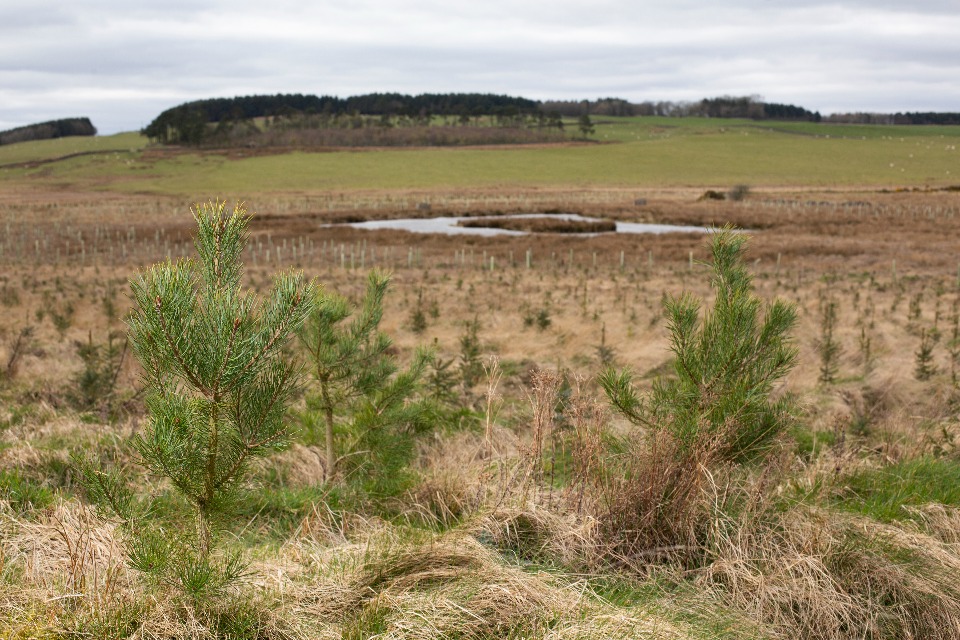
Newly planted trees on a site, surrounding a small body of water. Crown copyright.
Our top tips
-
Refer to this timeline for an overview of what to expect. Every project is different, so plan ahead to avoid any unnecessary delays.
-
Be flexible, reviewing your objectives and design where new information or constraints are discovered.
-
Keep track of stakeholder engagement, including emails and letter exchanges, in a backed-up location as this will need to be evidenced.
-
Consult with your local Forestry Commission team for support and resources to help you along the way.
-
Consider hiring a forestry or land agent. There will be costs involved, but they can help you from application, to planting, and establishment.
Make sure you don’t start work before you have a signed agreement from the Forestry Commission.
Additional information
How to select the right tree species
To create a resilient woodland, aim for a varied structure in age, species, origin, and open space. Consider the risks and opportunities of climate change and vulnerability to pests and diseases to help decide whether alternative or increased species diversity are needed.
No more than 65% of the area can be allocated to single species, and all sites should incorporate a minimum of 10% of other tree species, 10% open ground or ground managed for biodiversity and 5% native broadleaved trees or shrubs. Natural colonisation from nearby trees and shrubs can make an important contribution.
Where more than one species is suited to a site and matches the management objectives, opportunities must be taken to diversify your species composition. For woodlands under 10 hectares and in native woods, proportions may be relaxed if the adjacent land uses provide diversity.
How to source your trees
To be eligible for grant support, use plants and trees that are free from pests and diseases. Your plants must come from suppliers who meet the Plant Health Management Standard and evidence of this must be supplied when you claim for your trees.
Nurseries can demonstrate compliance in 2 ways:
-
Plant Healthy certification. Certified nurseries and those in the process of certification (within 12 months) can be found on the Directory of Certified Businesses.
-
Ready to Plant (RtP) assessment. Non-certified nurseries must show their compliance with the requirements through a RtP assessment. Each nursery you order from must apply for an RtP and include your EWCO reference number. Find out more about Ready to Plant.
If you are not purchasing your trees from a commercial supplier, you will be exempt from this requirement, however, we recommend that exemptions are requested at application stage. You must wait for approval before sourcing the trees.
As part of your application, you will be asked about your intended supply. You should speak to this nursery to ensure sufficient planting stock will be available for your project. Though, you are not obligated to stick with this choice.
Thinking ahead will help the nursery, and you are more likely to get quality trees at the best price. If you want unusual species, or specific provenance, this is even more important. If plans change, keep your intended nursery in the loop, as they will be able to advise you if there are any issues.
How to choose a method for creating your woodland?
EWCO supports 2 methods for establishing your woodland: planting and natural colonisation. You can use these methods individually or in combination.
Planting young trees manually or with machinery provides greater control and offers various techniques such as pit planting, slit planting, or T-notch planting. Natural colonisation occurs when trees establish and grow without human intervention, which typically reduces costs and increases biodiversity value. It relies on seed dispersion by wind, water, or wildlife. EWCO may support natural colonisation if there is a seed source of at least two tree species within 75 metres of the land, at your woodland officer’s discretion.
The method you choose depends on site characteristics, existing features, the degree of control required, tree species, and your objectives, all of which will be highlighted during the woodland design process.
Details on EWCO requirements for planting area, stocking, and species, as well as how to support and monitor natural colonisation can be found on the EWCO application page.
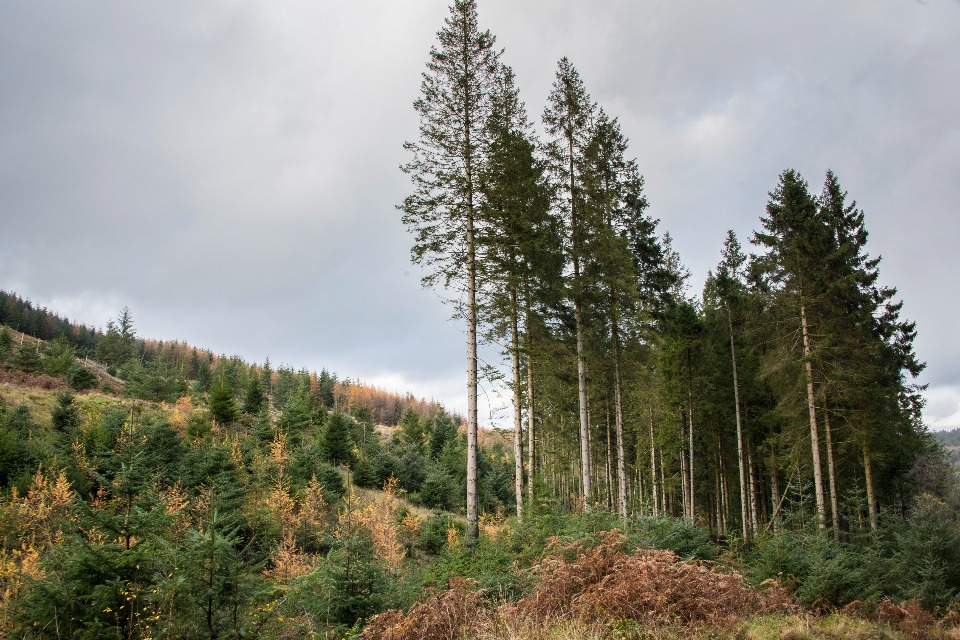
Conifer woodland with varied age structure. Crown copyright.
Forestry Commission grants
Woodland Creation Planning Grant (WCPG)
WCPG contributes towards the costs of designing your new woodland in line with the UK Forestry Standard, and offers you access to expert advice from us to assist in the production of your plan.
England Woodland Creation Offer (EWCO)
EWCO covers standard capital costs and annual maintenance payments as your woodland establishes, with additional stackable payments when delivering wider benefits to society, nature recovery, and the environment.
In addition to our grants, our partners can fund a range of woodland creation projects, offering you the flexibility and financial support to plant. Read more on our funding and advice overview.